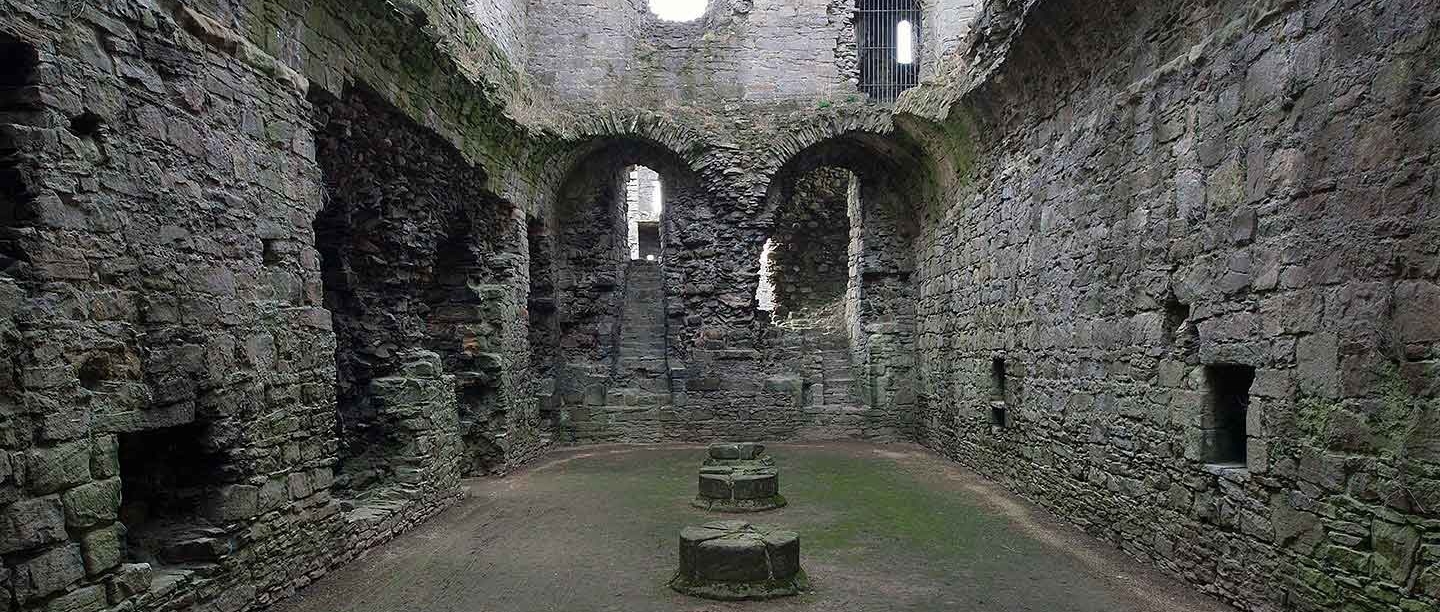Keep: Exterior
The great tower or keep is the most imposing building in the castle. It stands at about 49 feet (15 metres) high, 78 feet (24 metres) wide and 105 feet (32 metres) deep, making it one of the largest keeps in the country.[1] The keep was probably built in the late 12th century by a descendant of Alan Rufus.
The entrance to the keep was at first-floor level via a stone stairway. Halfway up the stairway on the right is a wide recess, which would have housed a small guardroom controlling access to the keep. A drawbar socket on either side of the recess and traces of masonry survive of two sets of doors across the stairs.
Read a History of Middleham Castle
Keep: Interior
The keep is divided down the middle by a spine wall. Immediately beyond the first-floor entrance was a vaulted ante-chamber, where visitors waited before being admitted to the great hall.
The hall was lit by windows in the north and east walls, and there was probably a dais for the lord at its north end. The hall was heightened probably in the 15th century, creating a clerestory with large windows on the east and west sides to improve the light. This heightening may also have created an upper floor for extra lodgings.
A doorway in the hall’s north-east corner led to a small chapel, while the north-west doorway led to private accommodation on the keep’s west side. This consisted of a great chamber, with a fireplace, two cupboards and a wash basin, and a smaller inner chamber. This had its own door to the latrines, which were housed in turrets on the keep’s west side, and a small room in its south-west turret, probably for personal servants.
The south-east turret of the keep contains a fine staircase that runs from the kitchen and storage areas in the basement to the roof. Near the top, a narrow side staircase led to the battlements above the hall. Halfway up this side access, a further branch of steps was inserted in about 1400, giving access to two small rooms. These were perhaps private chambers to allow the Nevilles to admire the garden landscape to the south.
Chapel Tower
On the east side of the keep is the three-storey chapel tower, added in the first half of the 13th century. The chapel was on the second floor, supported with stone vaulting. Remains of the priest’s piscina (basin for water used during Mass) can be seen at the east edge of the south wall. The first floor was occupied by the clergy, while the ground floor was used for storage. The chapel could also be entered from the keep ante-chamber.
Download a plan of Middleham Castle
Curtain Wall and Courtyard Buildings
The keep was originally enclosed by a ditch, and probably timber defences – the remains of the ditch that once surrounded the castle are visible on its north and east sides.
In about 1300 the rectangular stone curtain wall was built around the keep, supported by small buttresses. Between the buttresses were lodgings and service buildings built at ground-floor level against the inside of the wall.
The wall and its corner towers were heightened in about 1400, with a series of first-floor chambers added to provide more comfortable accommodation for the increasingly important Neville family, their guests and staff.[2] At the same time, timber bridges were added to link the wall with the keep on the south and west sides.
More kitchen facilities were inserted in the 16th century, including a bakehouse in the south range and pastry in the west range. The south range also includes a circular horse-mill, inserted much later, possibly in the 18th or 19th century.
Buy the guidebook to Middleham Castle
Gatehouse
The original gatehouse lay on the castle’s east side, through an outer court or bailey that is now built over. The footings of this gatehouse survive.
A new main entrance was created in about 1400 by inserting a passage through the curtain wall’s north-east tower. This gatehouse was heightened in about 1440 to create a third floor – turrets were built up from the north-east tower to rise high above the battlements.
READ MORE ABOUT MIDDLEHAM CASTLE
DOWNLOAD A PLAN OF MIDDLEHAM CASTLE (PDF)
Find more property HistoriesFootnotes
1. RA Brown, English Castles (London, 3rd edn, 1976), 72–4; DF Renn, Norman Castles in Britain (London, 2nd edn, 1973), 243–4.
2. A Emery, Greater Medieval Houses of England and Wales, 1300–1500, vol 1: Northern England (Cambridge, 1996), 368–72; BM Morley, ‘Aspects of fourteenth-century castle design’, in Collectanea Historica: Essays in Memory of Stuart Rigold, ed A Detsicas (Maidstone, 1981), 109–11.
